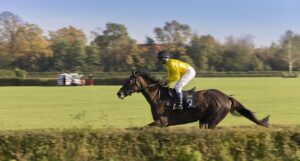 ‘Withers’ is a plural noun used to describe a single feature in a horse, specifically a ridge located above and just behind the shoulder, between the shoulder blades. The term was first recorded in the first half of the sixteenth century and its origin is uncertain, although it may be derived from the Old English prefix ‘wither’, meaning ‘in opposition’ or ‘against’; the withers are the part of the body that resists the strain of the collar when a horse is hitched to a load.
‘Withers’ is a plural noun used to describe a single feature in a horse, specifically a ridge located above and just behind the shoulder, between the shoulder blades. The term was first recorded in the first half of the sixteenth century and its origin is uncertain, although it may be derived from the Old English prefix ‘wither’, meaning ‘in opposition’ or ‘against’; the withers are the part of the body that resists the strain of the collar when a horse is hitched to a load.
The withers are the highest part of the back of a horse and, granted that they are only portion of the topline that remains unchanged, regardless of any movement of the head or back, the traditional reference for measuring height. Anatomically, though, the withers are a key anchor point for the ligaments and tendons that support the neck, shoulder and back. As such, the position and shape of the withers play a pivotal (no pun intended) role in the mechanics of movement, principally of the shoulder, which influences the stride length, speed and jumping ability of the horse in question.
Each vertebral body in the backbone of a horse is topped by a long, thin, bony spur, known as the dorsal spinous process. In the withers area, which is formed by the second to twelfth thoracic vertebrae – so-called because they sit directly above the thorax, or chest – the dorsal processes are especially long, as long as 12 inches or more, in extreme cases. The thoracic vertebrae do, however, vary in height, such that the withers have an arched appearance. The tallest part of the withers, usually formed by the fourth, fifth or sixth thoracic vertebra, is always above the shoulder blades, such that the dorsal spinal process in susceptible to fracture if the horse falls over backwards or suffers some other form of trauma.
